The National Defence Academy of Austria regards itself as the highest educational and research institution of the Austrian Armed Forces, focusing its activities on military sciences. In accordance with Humboldt's principle of the unity of research and teaching, people from various institutes teach and conduct research in the fields of security policy and strategy, peace support and conflict management research, social sciences and the core disciplines of military science (military strategy, operations, tactics, command and control, military logistics). Research and development therefore generate findings and thus produce knowledge, whereby the distribution or exchange of this knowledge is an elementary cornerstone of a successful organisation (Bundesministerium für Landesverteidigung und Sport, 2011).
The exchange of knowledge between the company and its suppliers in a structured manner was also promoted by Toyota. The idea behind these efforts was that through coordinated and trust-based communication, knowledge can and must be transferred between areas or organisations that work together in a network. A part of this idea or approach will be examined in the context of the National Defence Academy. Even if the organisational structures are different, similarities can be identified. Researchers also form a network, both within and outside the National Defence Academy. However, the internal network of researchers at the academy is not very strong. Firstly, there have only been a few joint research activities in which the institutes of the National Defence Academy have worked together in recent years. And secondly, the sharing of knowledge is institutionalised in the form of researcher meetings, but the frequency of implementation, the topics covered and the organisation are not satisfactory.
The aim of this article is therefore to sharpen the focus of the researcher meeting in order to improve networking across various institutes of the National Defence Academy in order to promote scientific exchange and to develop synergy effects.
The fundamental question to be answered is: “What measures should be taken to improve the researcher meeting for mutual exchange between researchers at the National Defence Academy?”
Two methods were used to collect the data: Document analysis and a survey using an online questionnaire. The document analysis narrowed down the broad field of available literature (Döring & Bortz, 2016). In view of the objectives and the research question to be answered, the choice was therefore made between specialised military and civilian literature on the one hand and scientific publications dealing with the subject area on the other. In addition, the views and opinions of researchers were obtained by means of an online questionnaire. Subsequently the method of text and data analysis was used to analyse the data. The aim was to understand and reflect on the selected literature. Furthermore, the data collected in the course of the survey was analysed, compared and finally interpreted.
The questionnaire developed for this data collection is a fully structured, quantitative questionnaire (Hussy, Schreier & Echterhoff, 2013). Due to the objectives of the survey, researchers from different hierarchical positions and different institutes of the National Defence Academy took part. As a result of the diversity of the interviewees in terms of personnel group, research direction or duration of research activity, different experiences and objectives could be queried, which in turn provided valuable input for the evaluation and interpretation of the results.
The questionnaire was created by the author using the questionstar programme and the link was sent electronically to the respondents. The people available for selection (31 researchers are currently working at the National Defence Academy) were asked to take part in the survey by email on 27 November 2023. A reminder email was sent out on 11 December 2023. By 20 December 2023, the survey had been answered 20 times. This corresponds to a response rate of 65 per cent.
At the beginning, the reason for the survey was explained in a brief statement and reference was made to the data protection regulations and the voluntary nature of the survey. Following statistical questions on age, affiliation to an institute, group of persons and gender, four large blocks of questions had to be answered:
General information on the research network at the National Defence Academy,
General information about the researcher meeting,
Specifics about the researcher meeting I: frequency, and
Specifics about the researcher meeting II: topics to be dealt with.
The present research paper starts with an explanation of the research organisation of the National Defence Academy. The second main chapter discusses Toyota's approach as described by Dyer and Nobeoka and outlines the possible applications and transferability to the National Defence Academy. While the questionnaire is analysed in the third main chapter, the fourth main chapter discusses and interprets the results using the findings from the previous sections. It ends with some conclusions.
The National Defence Academy is the highest educational and research institution of the Austrian Armed Forces and is therefore considered the intellectual centre of the Ministry of Defence. This is particularly reflected by the fact that it “conducts military science research and teaching at university level” (National Defence Academy, 2017, pp. 84). Regarding the research organisation, both the research management, implemented as an independent staff unit, as well as the following institutes are of relevance:
- –
Institute for Strategy and Security Policy,
- –
Institute for Peace Support and Conflict Management,
- –
Institute for Higher Military Education and
- –
Centre for People-Oriented Leadership and Defence Policy.
There are currently 31 people bearing the title of Researcher & Lecturer or Lecturer & Researcher in the mentioned institutes. The activities of the researchers (basic and applied research) lead to scientific findings, which form an essential basis for teaching activities. The findings are also published in the Academy's own media, such as the National Defence Academy publication series, the Military Science Journal of the National Defence Academy or the Military Science Publication Series of the National Defence Academy, as well as in recognised (military) scientific journals. Furthermore, results are also presented at national and international military science symposia and conferences, such as the biennial “Military Science Conference” in Vienna, which is hosted by the University of Applied Military Sciences. Finally, the findings are used in media work (e.g. interviews with experts on current conflicts) as well as in co-operation and training with various companies (e.g. Austrian Federal Railways).
The publication and presentation activities of researchers can be categorised as part of the academy's Third Mission. In other words, it involves disseminating knowledge gained to society, politics or business.
The Austrian author Marie von Ebner-Eschenbach already stated in the 19th century, “knowledge is the only good that grows when it is shared”. More than 100 years later the organisational scientist Gilbert Probst (2011) made the statement that “sharing knowledge means multiplying knowledge”, underlining the importance of knowledge transfer within organisations. Moreover, knowledge exchange focusses on individuals because they are the primary knowledge carriers (Müller, 2009). Grasshoff (2023) underlined the statement of Müller and developed the concept of collaborative knowledge management. This means that knowledge management cannot be done for the employees of an organisation, but only together with them. Offergelt, Hofreiter and Steiner (2024) found that knowledge is a competitive advantage and good knowledge management promotes the exchange of information between members of the organisation. Through knowledge sharing, teams and individuals can share ideas and learn from each other, leading to better collaboration and improved performance. As already stated, the organisation must create the framework conditions for a formal exchange of knowledge. For example, knowledge exchange meetings, world cafes, online forums or cross-training programmes can institutionalise and promote knowledge exchange (Heisig, 2023). The University of Vienna (n.d.), for example, implemented different Hubs to bring researchers from various disciplines together and deepen the engagement between them.
In this sense, Toyota developed and implemented a model to increase the distribution of knowledge based on four pillars: (1) Supplier association, (2) Consulting teams, (3) Voluntary learning teams, and (4) Interfirm employee transfers.
Due to the scope and objective of the research paper, only the first pillar will be discussed and briefly explained. In a second step, the researcher meeting implemented at the National Defence Academy is examined in order to draw initial conclusions in a third step.
The car manufacturer Toyota, like many other large companies, was faced with the problem of co-ordinated knowledge transfer within its core operations, but also with its suppliers. In 1943, the supplier association was founded with the purpose of “promoting mutual friendship and the exchange of technical information between Toyota and its suppliers” (Dyer & Noboeka, 2000, pp. 352). In line with the motto “Progress through Sharing”, the members of the network are supported in various areas in order to fulfil the Group's requirements (Toyota Kirloskar Suppliers Association, 2020).
The aim was firstly to implement the exchange of information between suppliers and Toyota, secondly to promote development and training between the members and thirdly to strengthen the connection through joint events.
With regard to the first point, for example, meetings are held every two months at the highest management level to ensure a structured exchange of information with various focal points. These range from production plans and trends to the future direction of the company and the impact on suppliers. Meetings are also organised in dedicated specialist groups to share knowledge, experience and lessons learned with and among each other at working level. Whilst specially structured courses are offered for the second area, training and development, mutual visits to production sites with subsequent informal meetings are planned to increase cohesion. All these measures develop links between members and ensure the exchange of information and knowledge, thus creating a sense of identity.
According to Bundeskanzleramt Österreich (2017), the organisation must first define who is to be informed about existing knowledge and to what extent. The instruments can be workshops, jour-fixes or newsletters. For exchanging information and knowledge among researchers at the National Defence Academy the researcher meeting was introduced around ten years ago. The aim was to ensure the structured networking of researchers from different fields of research. From the author's point of view, the objective was therefore entirely understandable. However, over the last few years, it has become clear that the frequency of the event and the topics covered no longer represent the original idea.
The last researcher meeting was held in December 2022, although the number of participants was quite manageable. Of a total of 31 researchers, only 12 from various institutes of the National Defence Academy took part. From the perspective of the author, who attended the researcher meeting himself, the content was also only partially adapted to the format. This view was confirmed by several informal talks and the empirical study, which is discussed in chapter 5.
The knowledge, experience and skills of employees can be of strategic importance. They are always of strategic importance if this knowledge has a significant influence on the realisation of the company's strategic goals and thus supports the long-term survival of the company (RKW-Kompetenzzentrum, 2013). Although that the knowledge sharing process is difficult to organise in practice, it must be done.
Both the Toyota company and the National Defence Academy produce knowledge. Similar instruments are used to ensure that this knowledge is not lost and is used within the organisation. The supplier association and the researcher meeting are similar in nature. It is about the transfer of knowledge from one area, be it different suppliers or institutes, to another area. The method is also similar: structured meetings of people to exchange information on specific topics. However, Toyota goes even further by offering its own courses and also organising joint events. Overall, Toyota's implementation appears to be more comprehensive and therefore more promising, perhaps also because the suppliers naturally do not want to lose their orders. The National Defence Academy does not offer structured, cross-institute further training in research-relevant topics or joint activities for researchers. For these reasons, further development appears necessary.
The results of the survey are analysed as pie charts or bar charts. In cumulative bar charts (Figure no. 4 to 7), negative responses are shown in red (doesn't apply), agreeing responses are shown in dark-green (applies) and neutral answers are shown in grey (partly/partly).
Based on the information provided by the participants, it can be seen that around one third belong to the Institute of Higher Military Education, another third to the Institute of Peace Support and Conflict Management and a further third to other institutes (see Figure no. 1). While 12 of the participants are military personnel, eight of them serve as civilian staff.
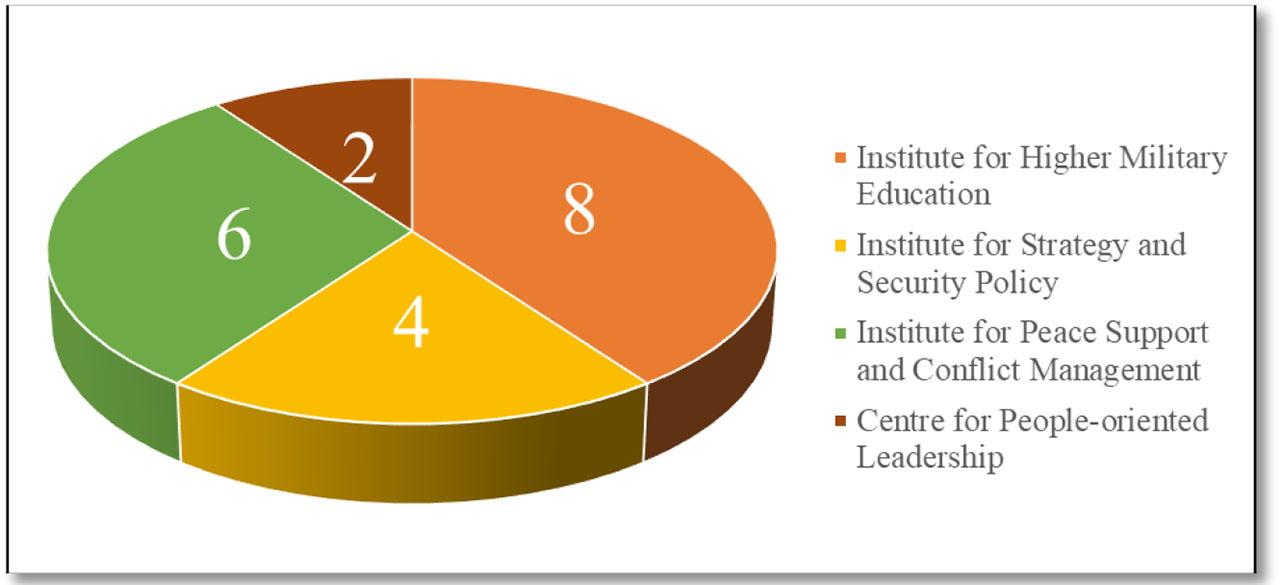
Institute of the participants
(Source: Created by Author)
With regard to the age distribution, it can be seen that people rarely start working in the field of research and teaching at the beginning of their career in the Austrian Armed Forces. Therefore, there are no participants between the ages of 20 and 29 (see Figure no. 2). Only from the age of around 30 and with the appropriate experience are employees utilised in this area. Moreover, this utilisation lasts longer, as Figure no. 3 clearly shows. Almost 70 per cent have been working in research for more than 5 years.
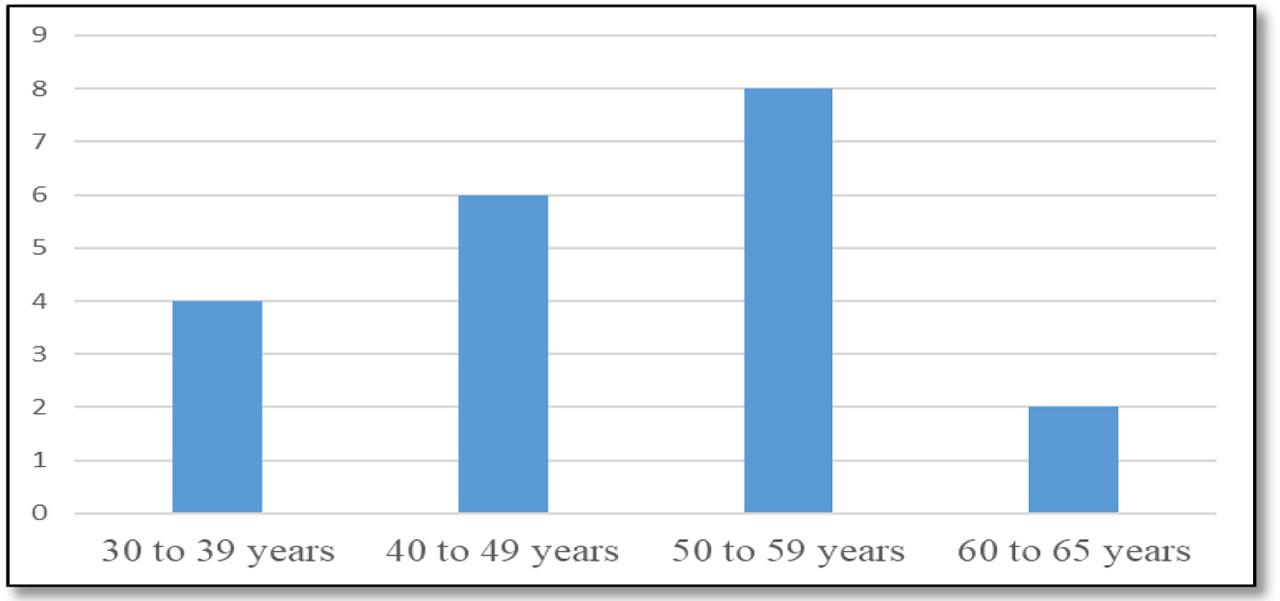
Age of the participants
(Source: Created by Author)

Duration of research activities
(Source: Created by Author)
Figure no. 4 shows the results relating to the research network at the National Defence Academy. Well over 90% of respondents are of the opinion that the transfer of knowledge between the institutes is not organised and that the exchange between researchers is not structured. This is confirmed by the fact that almost 90% are convinced that networking with other researchers takes place on their own initiative. 50% of the participants stated that they were aware of the research areas of the other institutes and that there were interdependencies. However, this does not mean that joint projects are carried out.
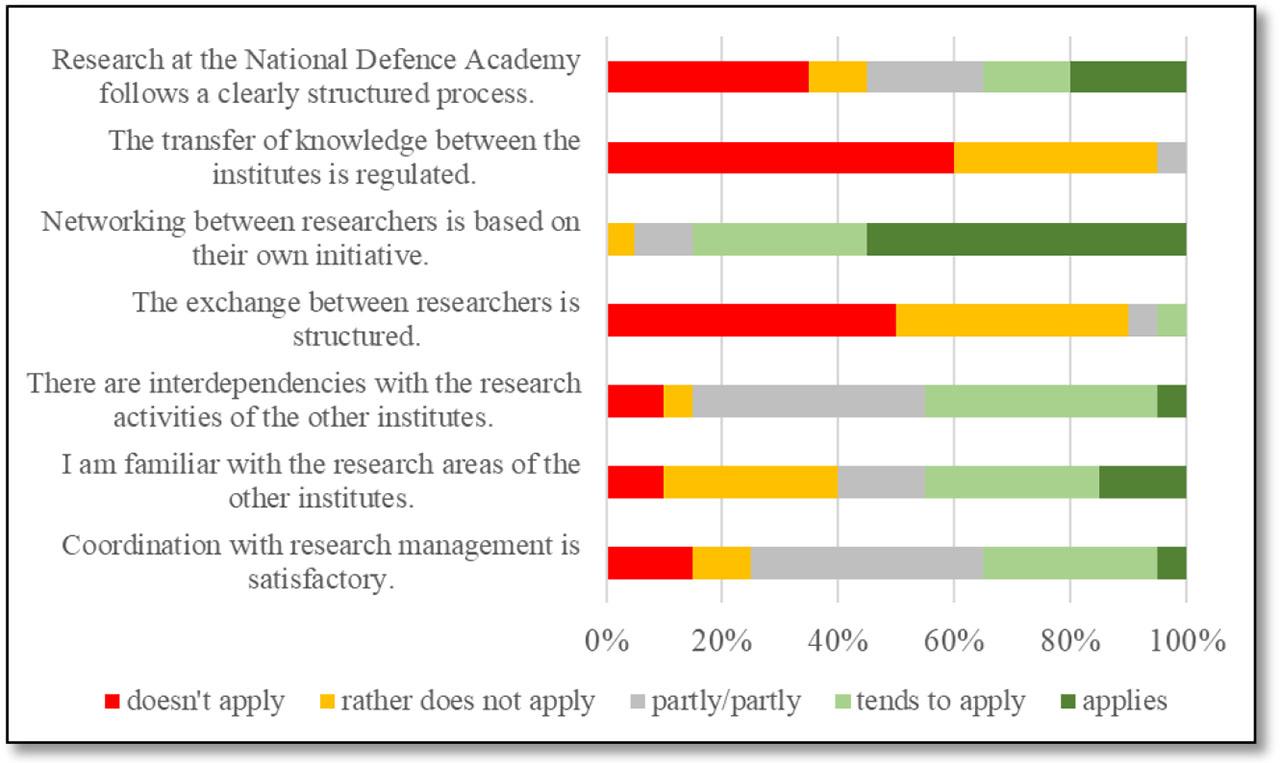
Research network
(Source: Created by Author)
Figure no. 5 shows the respondents' opinions on general questions about the researcher meeting. It is worth noting that the overwhelming majority believes that the timing of the researcher meeting is not included in the annual planning. Around 40% stated that they are not invited to the researcher meeting and that they are not aware of the purpose of the researcher meeting.
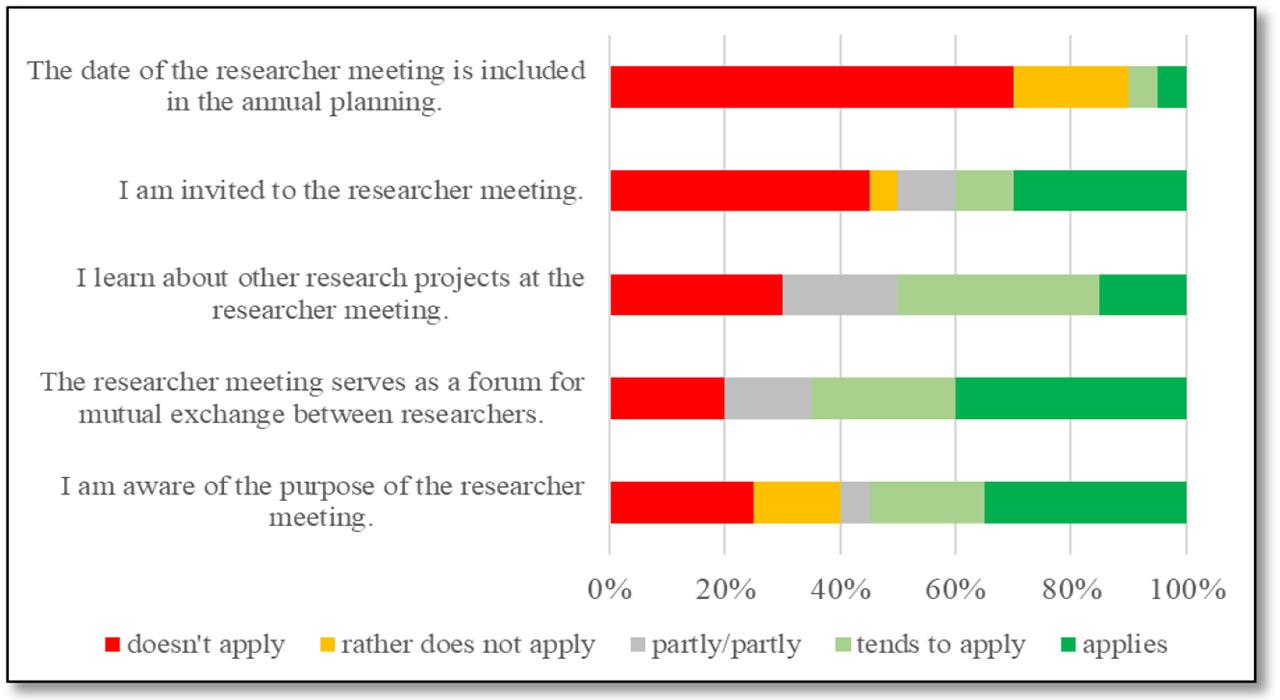
General information on the researcher meeting
(Source: Created by Author)
Figure no. 6 shows the opinion regarding the frequency of the researcher meeting. Almost 80% of respondents are of the opinion that organising monthly or annual meetings is not expedient. While almost 50% of respondents were in favour of holding the meeting every quarter, 35% were in favour of holding it every six months.
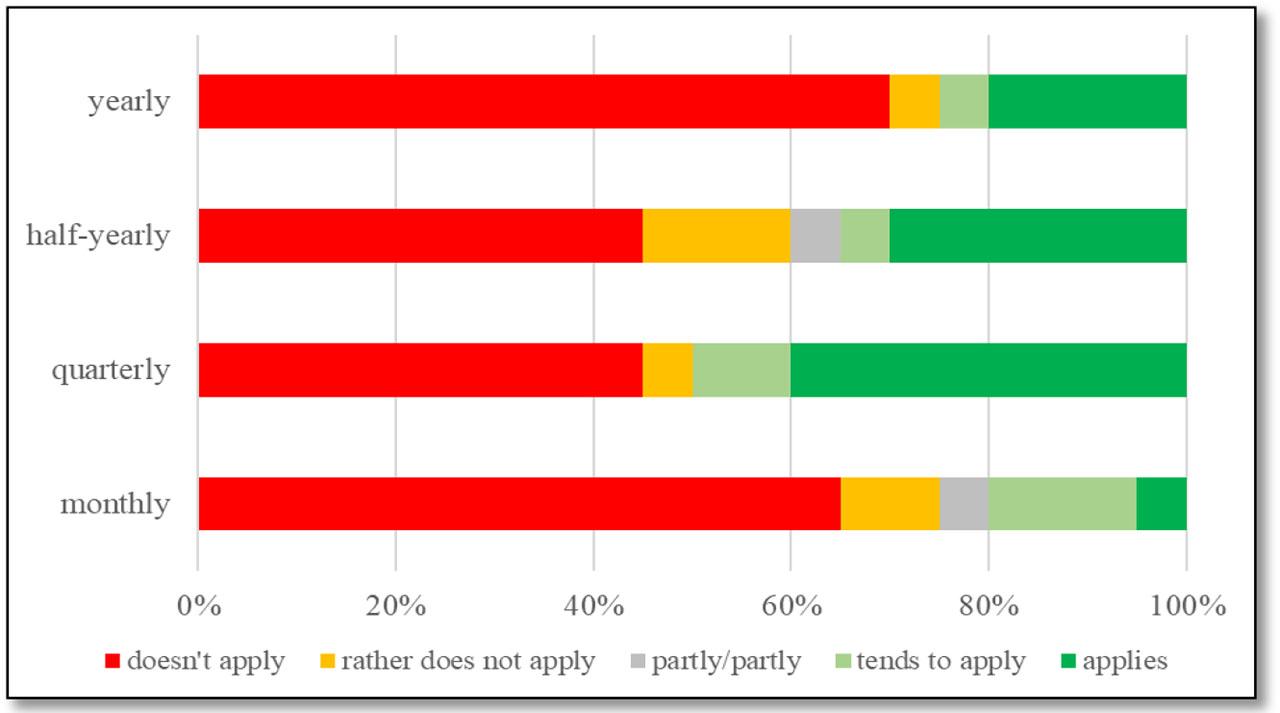
Frequency of the researcher meeting
(Source: Created by Author)
Figure no. 7 provides information on the results of the survey on the content and topics to be covered at the researcher meeting. Almost all respondents are of the opinion that ongoing research projects should be reported on. Approximately 85% also show interest in completed or planned research projects. In addition, 60% could imagine receiving information about the publication system, the research process or the funding of research projects.

Topics at the researchers' meeting
(Source: Created by Author)
The focus of the survey was to analyse the internal exchange of knowledge in general and the researcher meeting in particular at the National Defence Academy and not the dissemination of findings in the external scientific community. This could be a follow-on research. Due to the response rate of 65 per cent (20 out of 31 possible participants took part in the survey) it can be concluded, that the answers represent the view of the lecturers and researchers. The diverse composition of the participants in the survey also means that the study provides a comprehensive picture. Researchers, both civilian and military, from all four of the academy's teaching and research institutes took part, with ages ranging from 30 to 65 years and experience in research ranging from 5 to 30 years.
The representative survey of researchers at the National Defence Academy clearly showed that a researcher meeting can be an effective instrument for knowledge transfer within the organisation. Regular, planned and a structured organisation is therefore seen as absolutely necessary by the majority of those surveyed. This means that the timing of the researcher meeting must be included in the academy's internal annual planning so that personal plans can be harmonised with it.
In order to ensure mutual information, the researchers' meeting should be held twice a year. The majority of researchers rejected the idea of too frequent implementation as not useful. The location, time, programme and agenda should also be communicated to the institutes in good time by the responsible body, which in the view of the interviewees is the research management. In addition, invitations should be sent to the relevant group of people in order to ensure the participation of all researchers. In this context, it is important to note that researchers must be given the opportunity to participate.
In terms of content, it seems appropriate to prioritise the two researcher meetings to be held. For example, it would make sense to deal with general topics such as publishing, the research process or financing research projects in the first half of the year. The meeting in the second half of the year could be used to give researchers the opportunity to report on their completed and planned research projects. Future research projects in particular are in the interest of all researchers, as on the one hand there are links to their own projects and on the other hand synergy effects could be realised through participation.
The objective of the research paper was to refine the researcher meeting in order to better network the researchers from the various institutes of the National Defence Academy, to promote exchange and to develop synergy effects.
To this end, the first part of the study presented the approach to knowledge transfer at Toyota and the National Defence Academy and compared them with each other. This showed that similar instruments are available, but that the form and intensity of the exchange differ considerably. While Toyota's approach appears to be more comprehensive and therefore more promising, the exchange of knowledge at the National Defence Academy is not clearly structured. As a result, valuable knowledge is lost and cannot be utilised across institutes.
In the second part of the study, a quantitative analysis of the existing knowledge exchange at the National Defence Academy was carried out. It has been shown that organising the event in its current form is neither goal-oriented nor expedient. Rather, the researcher meeting should be relaunched in order to increase the transfer of knowledge within the academy, develop synergy effects between the institutes and thus strengthen research. The following findings with regard to frequency, content and organisation should provide an impetus for this.
In terms of scheduling, the author recommends that the meeting shall be carried out every six months. In this context, however, it is crucial that the dates are already set in the annual planning in order to make it easier for researchers to organise their personal schedules.
In terms of content, it can be stated that both research results and planned research projects should be presented. Information can also be provided on other research-related topics (e.g. process, funding, publications).
In addition, an informal part should be organised after the researcher meeting to enable researchers to get to know each other and exchange experiences.
Research Management is the organisational unit at the National Defence Academy that should be responsible for organising the researcher meeting. However, the extent to which it can take on this task in its current composition should be examined in a further step.
